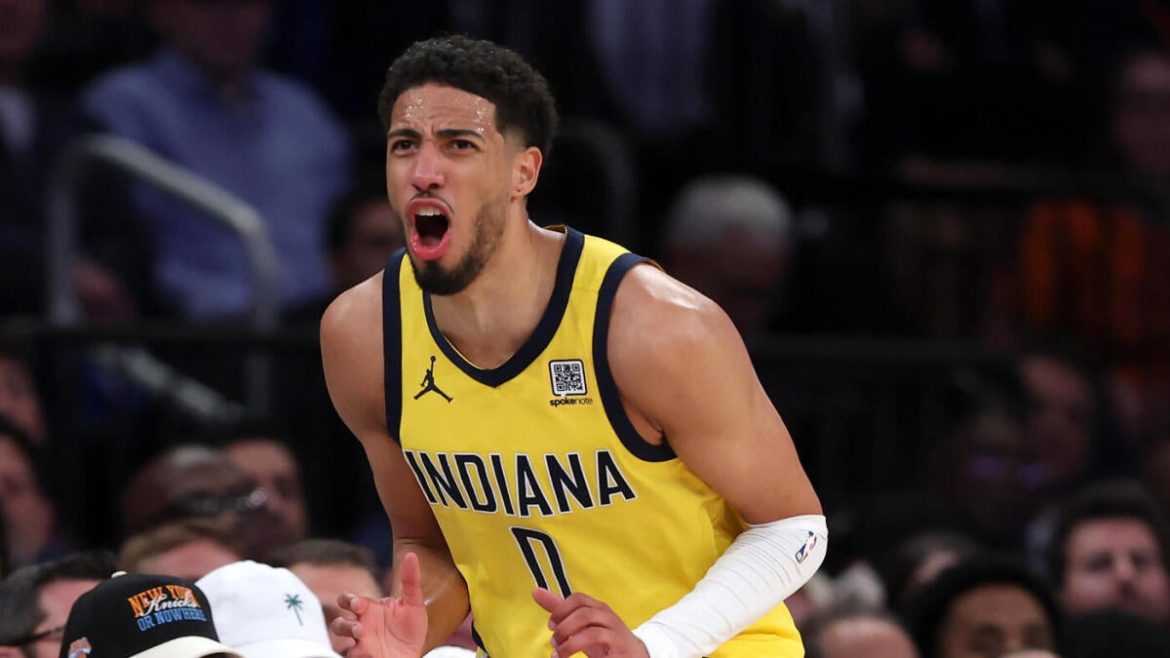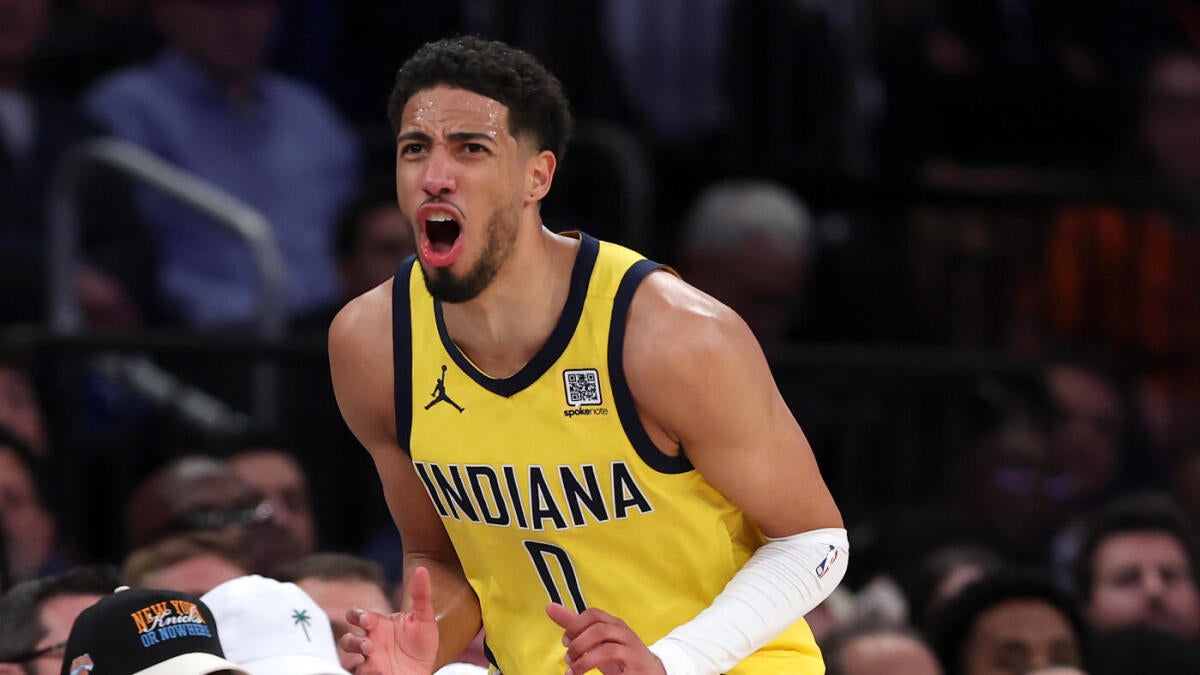The recent Eastern Conference Finals clash between the Indiana Pacers and the New York Knicks unfolded as one of the NBA’s most dramatic and theatrically charged encounters. Tyrese Haliburton, the Pacers’ All-Star guard, emerged as both the protagonist of the game’s astonishing comeback and the viral symbol of its absurd, unforgettable moments. His performance and postgame antics, especially his iconic “choke” gesture, have reignited echoes of a historic rivalry steeped in playoff lore, with shades of Reggie Miller’s legendary confrontations at Madison Square Garden. This report delves into the narrative arc, key moments, cultural significance, and aftermath that defined Game 1, illustrating why this contest was truly “too absurd for words.”
—
The Stage Was Set: A Comeback for the Ages
Late in Game 1, the Pacers faced a seemingly insurmountable deficit, trailing the Knicks by 14 points with under three minutes remaining in the fourth quarter. Such a large gap so late in a crucial playoff game—especially in hostile Madison Square Garden—usually signals a near-certain defeat. Yet, it was precisely at this point that Haliburton and his teammates unleashed an extraordinary surge. The Pacers clawed their way back, showcasing resilience, precision, and composure.
Haliburton himself became the fulcrum of the comeback. His scoring, ball distribution, and poise under pressure reversed momentum. Moreover, his game-tying buzzer-beater sent the contest into overtime, sparking wild celebrations on the Pacers’ bench. This moment captured much of the game’s drama—an improbable rescue from the jaws of defeat.
—
The Choke Sign: A Visual Taunt Rooted in Playoff History
Beyond the scoreboard, Haliburton’s gesture after the buzzer-beater catapulted the spectacle into the realm of theatrical basketball history. Channeling Reggie Miller’s iconic “choke” sign—famously directed at Knicks superfan Spike Lee during a 1994 playoff duel—Haliburton delivered a gesture loaded with meaning and provocation. Displayed live with Miller himself calling the game on TNT, this act was both homage and psychological jiu-jitsu, taunting the Knicks fans and echoing past Pacers triumphs over New York.
The scene carried added gravitas by featuring Miller, a retired NBA legend and Hall of Famer intimately connected to Pacers-Knicks playoff history. Haliburton’s celebration was not just a fleeting emotional outburst but a deliberate theatrical move that tapped into rich rivalry mythology. By donning a sweatshirt emblazoned with that very image postgame, Haliburton cemented his role as the current torchbearer of that legacy.
—
The Absurdity and Viral Afterlife of the Game
Characterized by improbable comebacks, buzzer-beaters, and larger-than-life taunts, this game transcended normal playoff narratives to enter the realm of the surreal and absurd. For many, it felt like watching a WWE storyline unfold live on the basketball court, with all the dramatic beats of rivalry, redemption, and showmanship.
Haliburton’s choice to follow up his choke sign with a casual grab of pineapple from the postgame spread captured the unpredictable, almost whimsical nature of the evening. This gesture, interpreted by many as a nonchalant ritual amid chaos, has been widely circulated and emblematic of the night’s strange combination of intensity and levity.
Meanwhile, social media erupted with vivid debate, memes, and fan reactions, ranging from praise and awe for Haliburton’s boldness to skepticism and chiding for some of his off nights—such as a subsequent frustrating shooting performance against the Knicks. The duality of his status as both hero and occasional target of criticism only enhanced the narrative drama surrounding him.
—
The Competitive Ramifications and Series Context
The Pacers’ Game 1 victory—snatched against the Knicks in overtime—was significant for more than just its entertainment value. It shifted momentum in the Eastern Conference Finals, giving Indiana a psychological edge reminiscent of past series upsets. The Knicks’ collapse from a 17-point advantage late in the game echoed the many recent “choke” moments Haliburton’s sign referenced.
Haliburton’s performance throughout the series carried the weight of leadership: supplying 26 points in Game 1, orchestrating plays during the comeback, and standing tall despite personal shooting struggles in later matchups. His mix of clutch scoring and confident showmanship made him the focal point for both the Pacers’ success and future pressure.
—
Legacy and Cultural Resonance: The New Villain of Madison Square Garden?
The Pacers-Knicks rivalry has long been one of the NBA’s most storied, fueled by historic figures like Reggie Miller and the intense fan atmosphere at MSG. Tyrese Haliburton’s embodiment of that legacy, both through play and symbolic gestures, situates him as perhaps the NBA’s modern “villain” in New York’s eyes.
Knicks fans, social media warriors, and even legendary figures have witnessed a new chapter of psychological warfare and competitive edge. Haliburton’s mimicry of Miller’s choke sign—using it not only as a celebration but as a form of trolling postseries with apparel and chants—cements his place in the rivalry’s folklore.
This persona, a delicate balance of fierce competitor and entertainer, ensures that future encounters between these teams will carry an added layer of dramatic tension and narrative richness.
—
Conclusion: An Encounter Written in Theatrics and Basketball Brilliance
Game 1 of the Eastern Conference Finals between the Indiana Pacers and New York Knicks transcended the typical playoff contest. It became a lived drama involving David-and-Goliath-sized comebacks, pulse-pounding buzzer-beaters, symbolic taunts a quarter-century in the making, and moments of absurd levity like Haliburton’s pineapple snack. This game was a microcosm of sports theater: intense, unpredictable, and deeply rooted in historical rivalry.
Tyrese Haliburton emerged as a charismatic figurehead of this saga, fusing athletic excellence with psychological bravado. By channeling Reggie Miller’s iconic choke sign and adding his own flair, he reminded fans why basketball is as much about storytelling and personalities as it is about points and rebounds. As the series continues, the stage is set for more thrilling chapters in a rivalry that feels as vibrant and “absurd” as ever. The legacy of this game—its wildly improbable comeback, its theatrical taunts, and its viral moments—will be remembered as one of the defining clashes of the 2025 NBA postseason.





